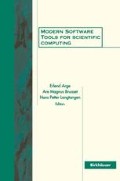Abstract
This contribution presents the major design abstractions identified in the course of an object-oriented C++ software project, named EL e M D, for solving a system of partial differential equations (PDEs) numerically. The main application area of this project is electrochemical modelling where the complex interaction between electrochemical mass and charge transport on one hand and the flow phenomena in the electrolytic solution on the other hand are to be modelled in an integrated manner. The most important abstractions in EL e M D deal with the analytical equations to be solved, the local discretization schemes, the material properties, iterative schemes, etc. They were often the result of evolving requirements imposed on the project.
Access this chapter
Tax calculation will be finalised at checkout
Purchases are for personal use only
Preview
Unable to display preview. Download preview PDF.
References
René Abgrall. Design of an Essentially Non-Oscillatory reconstruction procedure on Finite Element type meshes. Technical Report 91–84, ICASE, December 1991.
John J. Barton and Lee R. Nackman. Scientific & engineering programming in C++. C++ Report, 5(7):26–31, September 1993.
Grady Booch. Object-Oriented Analysis and Design with Applications. ISBN 0–8503–5340–2. Benjamin/Cummings, Redwood City, CA, 1994. Second Edition.
Leslie Bortels, Johan Deconinck, and Bart Van Den Bossche. The multi-dimensional upwinding method as a new simulation tool for the analysis of multi-ion electrolytes controlled by diffusion, convection and migration. Part I. Steady state analysis of a parallel plane flow channel. J. Electroanal. Chemistry, 404:15–26, 1996.
Bart Van Den Bossche, Leslie Bortels, Johan Deconinck, Sven Vandeputte, and Annick Hubin. Numerical steady state analysis of current density distributions in axisymmetrical systems for multi-ion electrolytes: Application to the rotating disc electrode. J.Electroanal. Chemistry, 411:129–143, 1996.
Frank Buschmann, Regine Menier, Hans Rohnert, Peter Sommerlad, and Michael Stal. A System of Patterns. ISBN 0–471–95869–7. John Wiley & Sons, 1996.
Robert L. Clay and Kenneth J. Perano. ISIS++: Using object-oriented design for improved component integration and solution adaptibility. In Sci Tools ‘86 International Workshop on Modern Software Tools for Scientific Computing, see http://www.oslo.sintef.no/SciTools96/, Oslo, Norway, 16–18 Sept. 1996.
T.S. Collins and J.C. Browne. МaTRiХ++: An object-oriented approach to the hierarchical matrix algebra. In Allan Vermeulen, editor, Second Annual Object-Oriented Numerics Conf., Sunriver, Oregon, April 24–27 1994. Rogue Wave Software.
Johan Deconinck. Current Distribution and Electrode Shape Changes in Electrochemical Systems. Springer-Verlag, Berlin, 1992.
Thierry Driesens, Gert Nelissen, and Johan Deconinck. A generalised approach of Boundary Element and Finite Element Methods using object orientation. In 18th World Conference on the Boundary Element Method,Braga, Portugal, 1996.
Erich Gamma, Richard Helm, Ralph Johnson, and John Vlissides. Design Patterns: Elements of Reusable Object-Oriented Software. ISBN 0–201–63361–2. Addison-Wesley, 1995. Second Edition.
Maria Georgiadou and R. C. Alkire. Anisotropic chemical pattern etching of copper foil. III. Mathematical model of reaction and transport phenomena. J. Electrochem. Soc., 141:679, 1994.
Scott W. Haney. Is C++ fast enough for scientific computing? Computers in Physics, 8(6):690–694, November 1994.
Ami Harten. High resolution schemes for hyperbolic conservation laws. J. of Comp. Phys.,49:357–393, 1983.
M. Heroux, S. F. McCormick, S. McKay, and J. W. Thomas. Applications of the Fast Adaptive Composite grid method. In S.F. McCormick, editor, MultiGrid Methods - Theory, Applications and Supercomputing, volume 110. M. Dekker, 1988. Lect. Notes in Pure and Appl. Math.
Claes Johnson. Numerical Solution of Partial Differential Equations by the Finite Element Method. ISBN 91–44–25241–2. Studentlitteratur, Lund, Sweden, 1987.
Hans Petter Langtangen. Diffpack: Software for partial differential equations. In Allan Vermeulen, editor, Second Annual Object-Oriented Numerics Conf.,Sunriver, Oregon, April 24–27 1994. Rogue Wave Software.
D. J. Mavriplis and A. Jameson. Multigrid solution of the Euler equations on unstructured and adaptive meshes. Technical Report 87–53, ICASE, Hampton,Virginia, July 1987.
Gert Nelissen, Thierry Driesens, and Johan Deconinck. A generalised approach for the non-linear coupling of Finite and Boundary Element Methods. J. of Comp. Phys.,1996. submitted.
John S. Newman. Electrochemical Systems. Prentice Hall, Englewood Cliffs, N.J., 1991. ISBN 0–13–248758–6.
Carl F. Ollivier-Gooch. Multigrid acceleration of an upwind Euler solver on unstructured meshes. AIAA Journal, 33(10):1822–1827, October 1995.
Henri Paillère. Multidimensional Upwind Residual Distribution Schemes for the Euler and Navier-Stokes Equations on Unstructured Grids. PhD thesis, Université Libre de Bruxelles, Brussels, Belgium, June 1995.
Zhong H. Qiu. Boundary Element Method for Predicting Current Density Distributions in Electrochemical Systems. PhD thesis, Wessex Institute of Technology, UK, 1995.
Arch D. Robison. C++ gets faster for scientific computing. Computers in Physics, 10(5):458–462, September 1996.
Patrick Vankeirsbilck. Algorithmic Developments for the Solution of Hyperbolic Conservation Laws on Adaptive Unstructured Grids. PhD thesis, Katholieke Univ. Leuven, 1993.
Author information
Authors and Affiliations
Editor information
Editors and Affiliations
Rights and permissions
Copyright information
© 1997 Springer Science+Business Media New York
About this chapter
Cite this chapter
Nelissen, G., Vankeirsbilck, P.F. (1997). Electrochemical Modelling and Software Genericity. In: Arge, E., Bruaset, A.M., Langtangen, H.P. (eds) Modern Software Tools for Scientific Computing. Birkhäuser, Boston, MA. https://doi.org/10.1007/978-1-4612-1986-6_4
Download citation
DOI: https://doi.org/10.1007/978-1-4612-1986-6_4
Publisher Name: Birkhäuser, Boston, MA
Print ISBN: 978-1-4612-7368-4
Online ISBN: 978-1-4612-1986-6
eBook Packages: Springer Book Archive

